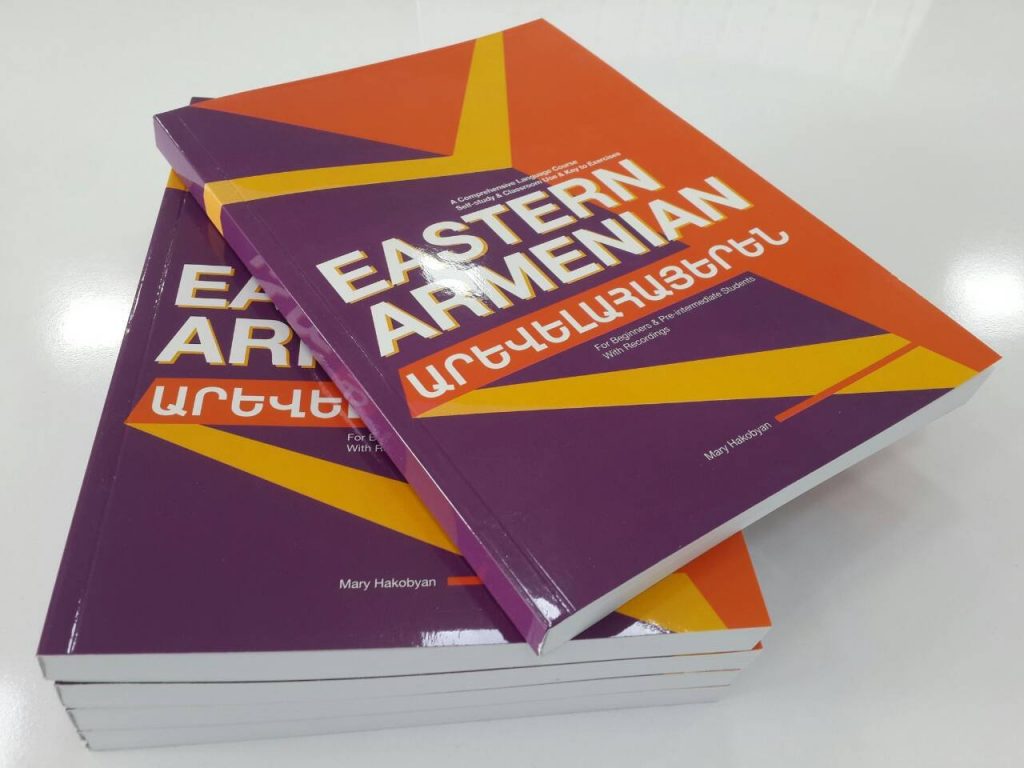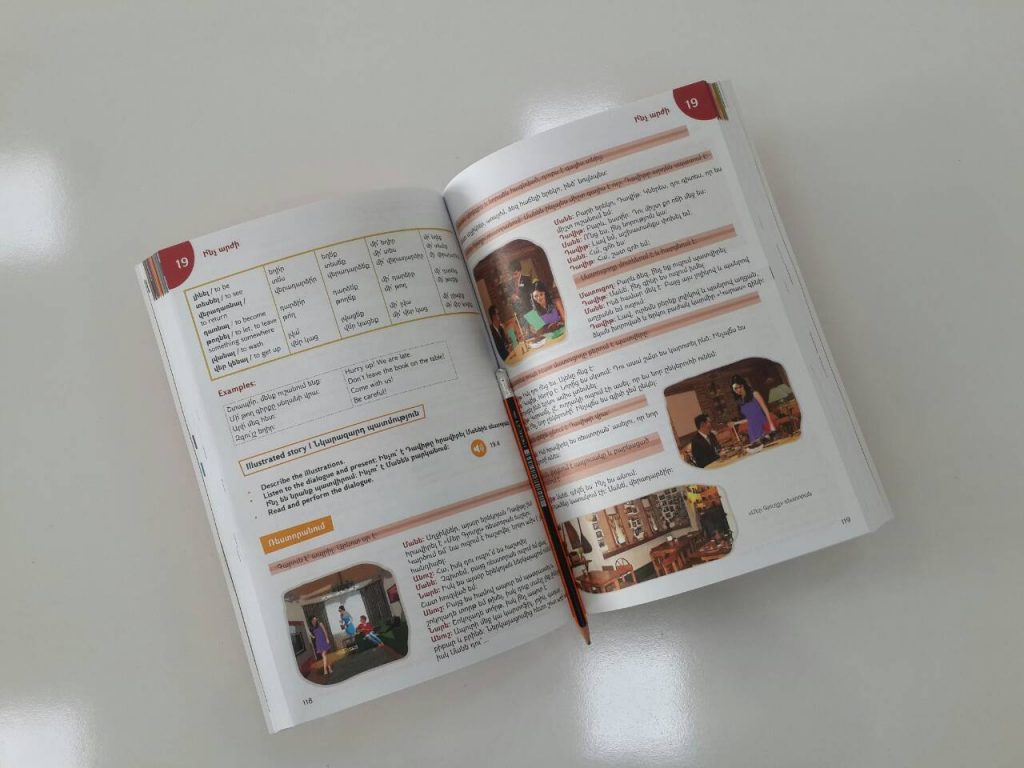Anyone that’s ever tried to learn Armenian eventually comes into contact with the bizarre duality of the language—namely, that there are two. And these two dialects are divided, as the rest of the world appears to be, between East and West.
But for all their differences, Eastern Armenian (the language spoken primarily in Armenia, the former Soviet Union, and Iran) and Western Armenian (the dialect spoken throughout the Diaspora) are united by the fact that the resources available to those who wish to learn either of them are in short supply. The market for Armenian-as-a-foreign-language textbooks, be they Eastern or Western, is a small one.
Mary Hakobyan, an Armenian teacher from Yerevan, has spent the last five years crafting her own pedagogy for teaching Eastern Armenian, which has recently been published as a textbook last February. Drawing from the pedagogies of existing methodologies, as well as her contemporary experiences as a language teacher who taught Armenian to young international volunteers through the Birthright Armenia program, Hakobyan says the self-published textbook is not just a form of language instruction, but a rather, glimpse into what life is like in Armenia today—and that exposing students to some of the cultural nuances has been key to her success in teaching.
I recently spoke to Hakobyan to discuss some of the intricacies and history of the Armenian language, its contemporary pedagogy, and the gap her new book is filling in the rather sparse market of Armenian language-learning resources.
***
Karine Vann: Before your book, what existing resources were there for people who wanted to learn Eastern Armenian?
Mary Hakobyan: I would say there are very few options. I’ll start by saying, if you want to learn English, French, Spanish, you will find hundreds of resources, books, methods. Each of them is different, each gives you something useful. Because these languages are very popular and international. For Armenian language, it’s not the case. Even during the Soviet Union, the main language was Russian. As there was no demand, there was no need to create lots of different resources to teach Armenian to foreigners. After the collapse of the USSR, the interest—especially from the Diaspora—grew, and the need to create new text books started to rise.
Most of the other textbooks are mostly grammar and exercise construction. I have mentioned in my textbook that I consulted other resources for the grammar theory, namely A. Gevorkian’s and D. Sakayan’s books, which were rather successful in their own style.
But to my understanding, the Soviet system of learning a foreign language focused on reading and writing most of the time, like knowing the grammatical rules; writing exercises; reading text. But modern teaching methods require more skills, like listening and speaking skills.
However, the Eastern Armenian Textbook is unique in its own way, which you will feel when you start studying with it.
K.V.: What is your book contributing to the pre-existing literature that wasn’t before? How is it unique?
M.H.: This is a new style in learning Armenian. My book has illustrated texts which are a series, which are a continuation of the same story. The stories correspond to the grammar and vocabulary of each lesson. There are two main “heros,” who are put in different situations, and they have to speak using a grammar style that corresponds with the topic. There is lots of discussion, you practice listening, reading, speaking, and you learn new vocab and you practice your pronunciation. I haven’t seen this kind of method in other Armenian textbooks so far.
And also, I have illustrations for exercises. Let’s say they learn directions. There is a map of Yerevan and they have to explain how to get around. I tried to make my textbook close to other modern pedagogies, even for other languages, like English, but based on rules which are specific to Armenia. I have seven years of experience, I know which grammatical construction corresponds to which scenario or topic. The idea was to have a more modern approach to learning, with illustrations.
There are also authentic photos, like if someone talks about visiting Tatev Monastery, I have pictures of the monastery. So it’s not just acquainting students with grammar and asking them to do exercises, but it’s showing them the culture and the country, the mentality, the behavior, everyday problems, routines. This makes the book and the process more interesting.
K.V.: Can you talk a little bit about your background and how you came to realize you wanted to dedicate your career to this?
M.H.: I graduated from Yerevan State University, the faculty of Romance and Germanic languages in 2007 with a Master’s Degree in Philology and I always loved learning and teaching languages. However; when I started working at Birthright Armenia in 2009, I realized that teaching Armenian was something I greatly enjoyed and I would like to dedicate my career to it, since you not only teach your language and culture, but you also learn a lot from your students’ language and culture. So, I started tutoring diasporans, ambassadors, diplomats and foreigners in Eastern Armenian with a self-developed curriculum, adopting an entirely new approach to teaching and learning Armenian.
K.V.: How long were you working on the book? Did you face any obstacles in getting it published?
M.H.: To tell you the truth, I never thought I would ever publish a book, let alone this kind of a comprehensive textbook. When I started working in Birthright Armenia, I struggled with the books and materials available there to teach Armenian and, at the same time, I could understand the difficulties and fears of my students. I had to write texts, exercises, create games and activities for every lesson. Soon, I realized that I had a lot of material and experience which I could put together for my lessons. In 2013 I started to design the main body of the textbook and then added the lessons one by one. By that time, I had a good understanding of the challenges of the learning process and designed the book to allow the students to overcome them with confidence.
Starting in 2014 I used this first draft of the book (without illustrations, photos and recordings) for my lessons – correcting, editing and evaluating it with my students. I decided to design, illustrate and record the dialogues to get the full potential of the teaching method but I couldn’t find any sources to finance this effort. I envisioned a high quality book to rival the best existing publications but it would crush the family budget. I experienced a great deal of disappointment after applying for financing to several Armenian business and education development-focused organizations and being rejected by all of them.
In 2016, with self and family financing, I finally launched the design process. It took more than a year to finish everything, which was, by far, more difficult for me than the development of the material in the book. The textbook is a result of my innovative teaching methods which I exercised with my students for many years and I hope that it will assist everyone to succeed in learning Armenian without fears, stresses and obstacles. I am sure that this textbook will help people really enjoy learning Armenian.
K.V.: In the past, I have encountered those who complain Eastern Armenian has been “diluted” by Soviet influence. Is that because Western Armenian is more related to grabar (classical Armenian)?
M.H.: I wouldn’t say that because Western and Eastern Armenian are two sister languages, and both are descended from grabar. Historically, Armenia was divided into two countries, that’s why the languages developed separately. So we have difference in vocabulary, in grammar, in pronunciation. I think probably Eastern Armenian was influenced a little bit by Russian language, because of the Soviet Union. But I would say that Western Armenian is influenced by other languages depending on where the community is.
K.V.: What do you mean by “influenced”?
M.H.: Well, it’s a natural process, all languages are influenced by other languages, this is how they develop. But when I say Eastern Armenian is “influenced” by Russian language, for example, I don’t mean that we have Russian words in our classical writing or reading or that we teach that. I mean that maybe you will hear Russian words on the streets, in their everyday language. Sometimes older generations who had Russian educations might pronounce Armenian words with a Russian accent.
K.V.: How did the linguistic rift between the two dialects occur?
M.H.: Well, the country was divided between Russian and Turkey. So, people who were living in the part that was occupied by Turkey, they developed Western. The other part developed Eastern. Eastern Armenian, we had a change in orthography during Soviet Union. But only very few changes occurred on the way you write, spelling rules. It didn’t change the grammar, pronunciation or anything. They say that they tried to simplify, because throughout the Soviet Union, it was very difficult to find educated people, so they were trying to foster literacy by simplifying the spelling, in order to help people to learn to read and write.
To tell you the truth, I participated in a language course many years ago, we were discussing exactly what changes occured during that time to the Armenian language and the only changes that occurred were some spelling changes. Like, we don’t write յ in front of հ anymore, we used to do it according with classical orthography. I mean, I was not there, I was not a witness to know exactly what they changed or what were their exact intentions, but the result is just that they changed some spelling rules. Six or seven, that’s all. Nowadays, I know some people who can write both, with the modern spelling, but also the old.
K.V.: So how do you account for the different pronunciation. There are more sounds in Eastern Armenian than in Western. What happened?
M.H.: When Mesrop Mashtots created the alphabet in 405 A.D., he created it exactly to suit the sounds that Armenians had at that time. So, we Eastern Armenians, preserved all the sounds until now. That’s why we have these cluster of consonants (like բ, պ, փ; or գ, կ, ք). Mesrop Mashtots created these symbols because we had these sounds.
K.V.:I see that the book is available for purchase in select bookstores in Armenia, but is there any way for people living abroad to purchase it outside the country?
M.H.: The Eastern Armenian Textbook was published very recently on February 16, 2018. As you noted, it is already available in a number of bookstores in Yerevan. It is available on Amazon for those who want to buy it outside of Armenia. The availability will be regularly updated on the book’s website and Facebook page.
The post In the Market of Armenian Language-Learning Resources, Every Book Counts appeared first on The Armenian Weekly.
Source: Armenian Weekly
Link: In the Market of Armenian Language-Learning Resources, Every Book Counts


